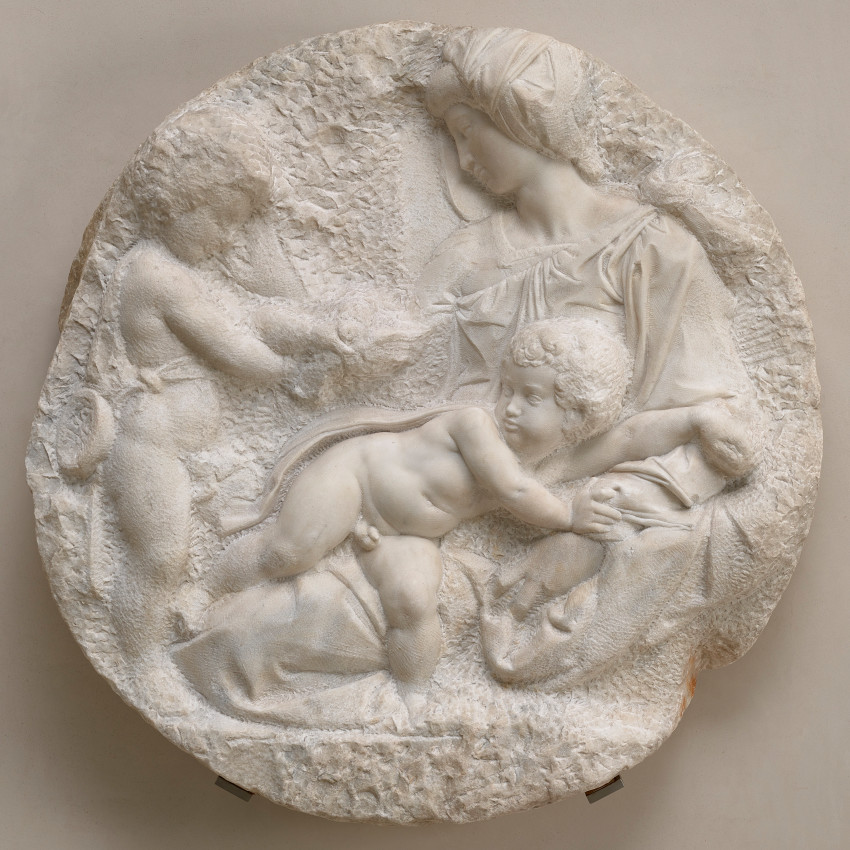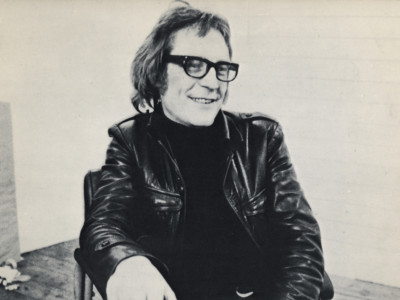
Bill Viola / Michelangelo: scenes from the extremities of life
By Ingrid Rowland
Published on 7 December 2018
We asked four writers to respond to key themes in ‘Bill Viola / Michelangelo’. On the subject of birth, art historian Ingrid Rowland reveals how both artists confront the particular and the universal in the cycle of life.
From the Winter 2018 issue of RA Magazine, issued quarterly to Friends of the RA.
The Royal Academy's exhibition Bill Viola / Michelangelo: Life, Death, Rebirth presents what its co-curator Martin Clayton calls "affective art", not only intimate creations like Michelangelo's drawings, but also works that engage some of our most powerful emotions by the magical transformation of what might seem to be the most aloof of media – Viola's stately, crystalline video projections and Michelangelo's hewn Carrara marble – into things that make our hearts burn within us.
The idea of exhibiting these two artists together came to Clayton, Head of Prints and Drawings at Royal Collection Trust, in 2006 when Viola, a careful student of the Old Masters, visited him at Windsor Castle, accompanied by Kira Perov, Viola's wife and studio director. The American artist was astonished by the very Michelangelo drawings displayed in the present exhibition. The two artists' work, centuries apart, explores the same universal themes, from emotional struggle and dreams to death and transcendence. Co-curated by Perov, the exhibition begins by confronting birth and motherhood through Viola's harrowing Nantes Triptych, of 1992, alongside several of Michelangelo's variations on a favourite theme: the Virgin Mary and her son.
The Nantes Triptych was commissioned by the French Centre National des Arts Plastiques for exhibition in a deconsecrated 17th-century chapel, part of the Nantes Musée des Beaux-Arts. By juxtaposing three half-hour videos on three adjacent screens, Viola adapted a traditional format for medieval altarpieces – painted and carved – to video. On the left-hand screen, a young woman gives birth; on the right, Viola's elderly mother lies seemingly close to death in a hospital bed; and in the centre a clothed, middle-aged man floats suspended in bubbling water. The soundtrack mixes aquatic noises with crying and breathing, the endless cycles of life.
Nantes Triptych
"...The triptych’s scenes from the two extremities of life – birth and death – are scenes of loving companionship." Watch an extract from Bill Viola's video work Nantes Triptych. Please note: this clip contains some nudity.
Viola's central Everyman floats alone in his fluid atmosphere, but strikingly the triptych's scenes from the two extremities of life – birth and death – are scenes of loving companionship. The young mother, recorded in a natural childbirth centre shortly after the birth of Viola's own son, squats firmly between the legs of a man, presumably the baby's father, who gently strokes her hair as the pain of labour increases to its climax, and a midwife grasps the newborn child and hands it to its mother, the umbilical cord still a fat, throbbing blue vein connecting them. Instantly, the mother's transports of agony turn into pure ecstasy, and the video ends with the scowling baby sticking out its tongue, a personality already as distinctively formed as its tiny hands and feet.
A cord of another sort connects the dying protagonist of the right-hand screen to a respirator. We see a woman lying open-mouthed on her back, shrouded in a white hospital sheet. We come to realise that she is a woman dearly loved, both by the elderly man who comes near to caress her face and hold her hand, and a younger man who mops away her saliva. The woman is Viola's own mother, the sorrowing husband is his father, and the younger man is the artist's brother. Viola was holding the camera, facing the impending loss of his mother the only way he knew how: through art. By focusing on her face, we see the occasional flutter of her unblinking eyelids and we know that she is still alive. As the shape of her mouth collapses into a triangle, the camera then pans up to show a paper decoration pasted to the wall: a child's drawing of a sunflower and the inscription: 'MOM YOU'RE THE GREATEST.'
At the very moment when the baby emerges into the light on the triptych's left panel and Mrs Viola's mouth goes slack on the right panel, on the central panel the floating Everyman comes up and we see his navel, the scar that marks us all as independent beings as it severs each one of us from the womb.
At times, while the 30 minutes of work tick by, this forced attendance upon a birth and an impending death seems like an unconscionable invasion of privacy. But the central panel, the stylised presentation of the floating man, turns heartbreaking particularity into universal human experience. MOM YOU'RE THE GREATEST, rather than an unbearably maudlin touch, reminds us that this dying woman inspires vivid passions.

Michelangelo Buonarroti's mother died when he was six, and like most of his contemporaries, he was sent out to a wet nurse as an infant. Because the family lived in the marble-rich mountains above Florence, Michelangelo declared that his ability to carve stone stemmed from the fact that he had drunk in marble dust with his nurse's milk. He also drank in a human compassion that was expressed most intensely in his depictions of the Virgin Mary and Jesus, whom he showed both as a rambunctious baby in his Taddei Tondo and as a dead child – his mother cradling that most terrible of burdens – in the heartbreaking sculptures he made of the Pietà.
In presenting the spiritual side of this great Florentine artist, 'Bill Viola / Michelangelo' also presents the social side of a man who was anything but a lone genius: he spent his exceptionally long, active life surrounded by crowds of friends, admirers and assistants (and complained in some of his poems about the irony of being an old man in love). Through his work, the motherless Michelangelo could throw his arms around suffering humanity as selflessly as any parent, but he could also stare down mortality with inimitable resolve. The Taddei Tondo, a small, private devotional image, dates from 1504, the same year as David, a colossal, glorious public monument to the Florentine Republic. Michelangelo carved marble more swiftly than his contemporaries, but he also took greater risks in carving. With David he turned a challenging block of marble into a triumph. With the Taddei Tondo, his chisel hit a flaw in the stone and produced a hairline crack that doomed any further progress. What survives, however, is more than enough to convey the torrent of thoughts that he and his contemporaries ascribed to the Virgin Mary. As a popular Tuscan preacher, Bernardino of Siena, said in 1427: 'I tell you, she saw and knew more all by herself than all the other creatures created by God', and that knowledge included the cruel, premature death of her son, signalled in the Taddei Tondo by the goldfinch clutched by the standing John the Baptist. A goldfinch is said to have removed a thorn from Christ's crown when he was carrying the Cross.
The squirming Jesus and his scarcely less lively cousin John provide a contrast to Mary's composure: she knows that both will die for their faith and that she is condemned to outlive them, to endure the double loss. By giving birth to Jesus, she has brought on his death. In the meantime, she lets her baby exercise his chubby limbs, fully aware that one day the adult man will lie slack in her lap. For the devoutly Christian Michelangelo, however, death to this life meant rebirth in the next. During Carnival in Florence, he would have seen people costumed as skeletons singing:
If everyone dies by living
If every soul lives by dying
The Lord of all Lords
Has established this law:
You all have to join in.
Repent! Repent!
By the mystery of this faith, death could become, in the words of the modern Greek poet George Seferis, the "birth pang of resurrection".
Ingrid Rowland is a professor at the University of Notre Dame School of Architecture, and co-author of The Collector of Lives: Giorgio Vasari and the Invention of Art.
Bill Viola / Michelangelo: Life, Death, Rebirth. Main Galleries, Burlington House, Royal Academy, 26 January – 31 March 2019. Exhibition organised by the Royal Academy of Arts, London in partnership with Royal Collection Trust and with the collaboration of Bill Viola Studio.
Related articles

Visions from Ukraine
19 June 2024

10 RA Schools stories through the centuries
16 May 2024

In memoriam: Mick Moon RA
1 May 2024